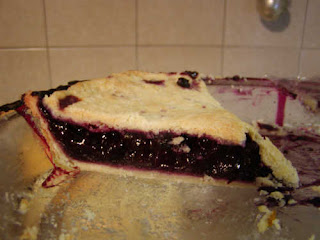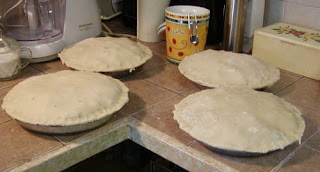
All through my youth, I thought a recipe was necessary to make a pies. If I came across fruit or berries on sale, I would first have to find a recipe for that particular one before I could make a pie with it. After years of practice I have hit on a method that works for me.

It is the filling I had trouble with until I developed this simple system.
Pie filling is basically prepared fruit and/or berries plus sugar and flour. You will need about 8 cups of prepared fruit that is washed, hulled, cleaned, cored, peeled and ready to put into the pie. The flour is to thicken it so you don't have runny pies and the sugar is purely for taste.
How much of each depends on your filling. You be the judge of how sweet you want it. I use 1 to 2 cups of sugar for every standard 9" pie made with fruit or berries. I put 1.5 cups of sugar in a blueberry pie but I don't like fruit pies very sweet. Some people might prefer 2 cups of sugar.
How much flour depends on how juicy the filling is. Again you have to judge the juiciness. I use between 4 and 6 tablespoons of flour for every standard 9" pie. Where the juiciness is concerned, I find it is better to use a little more than too little. No one likes a runny pie but too much flour will take away from the taste of the fruit. You cannot judge how runny it is while it is very hot, however. Let it cool to barely warm before making that judgement and adjusting the amount in the next one or the cooking time. If you have put in the 6 tablespoons of flour and it is runny, you probably haven't cooked it long enough. Also, if your pie is runny and you have thickened with flour, put it in the fridge overnight and it will be a lot more solid in the morning. If you used corn starch, this won't help.
You can bake the filling in a pie without burning the crust if you cover the entire pie with aluminum foil. If the pastry is getting dark and the filling is not done, cover the entire pie and bake longer.
If your most common problem in pie making is getting the filling completely cooked so that the fruit is soft and the juice is thickened but the pastry is not yet burned, try heating the filling up to the boiling point before your put it into the pastry. Only do this if it is going directly into the oven. The boiling filling will melt the fat in the pastry if you let it sit long like that without baking. I have cooked the filling completely before putting in the pastry and baking without any negative consequences. Then you are only baking the pastry and the filling is guaranteed to be fully cooked. However, if you want to ensure large pieces of fruit in the pie, I would not recommend this.
 Today I made four blueberry pies. I found frozen whole blueberries at Costco for a good price. I made the pastry yesterday. I baked one and put the other three in the freezer.
Today I made four blueberry pies. I found frozen whole blueberries at Costco for a good price. I made the pastry yesterday. I baked one and put the other three in the freezer.Pies taste just as good after freezing as they do fresh if they are frozen BEFORE THEY ARE BAKED. The quality suffers a lot if you freeze fruit and berry pies after baking. The filling will be fine but the pastry will be soggy.
Another tip: Do not keep cooked fruit or berry pies in the refrigerator. This will also make the pastry soggy. I cover mine with plastic wrap and keep it on the counter.
With these easy directions you can make pie out of anything. You can mix the filling as in peach/pecan or apple/maple/walnut with caramel drizzled on top. Use your imagination. If you have some fruit, but not quite enough, add some nuts and raisins to it. Use roasted hulled sunflower seeds in place of nuts in a pie. No one will know they are not nuts. You might also try substituting a little of the flour in the pastry with finely ground pecans. You can top the filling with bits of butter before putting the pastry on top. There are many, many variations you can make with this simple system for pie filling.
